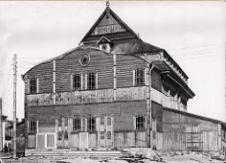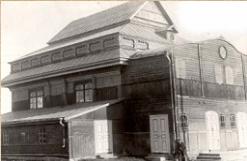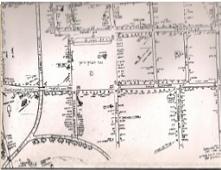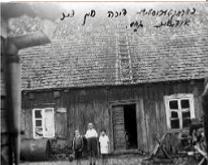Growing Up Under Russian Rule 1815 - 1914 Part 1
VILKAVISKIS
A small town in Southern Lithuania
Where the Jewish Community is no more
HISTORY FROM IMMIGRANT RECOLLECTIONS RELIVING THE PAST
What was life like for Jewish families who lived in Vilkaviskis during the decades between 1894 and 1911?
FAMILY LIFE CONSTRUCTING A HOUSE
Building an ordinary one-story house took three or more years to complete. 32 First the builder and his helpers went to the forest where they cut down the necessary trees. After measuring and re-measuring, they carefully sawed, chopped, hewed, and planked the trees until they formed the needed logs, boards and siding. This took about three to four months. Then they brought the lumber to town and laid it out on the market place field and the joists and planks were fitted taking another three to four months. Next came the foundation, and sometimes it was necessary to dig a cellar. Another three or four months were needed for framing the building. The siding, brick laying, and plastering consumed yet another three or four months. The roof, floors and final touches took additional time.
THE HOME AND FURNISHINGS
At the entrance to an average home in Vilkaviskis stood a kayle [barrel] filled with drinking water with a copper dipper on top, as well as an almer [cabinet that stores food] nearby. The almer contained ayngemakhtsn [preserves] with a warning: ―M‟zol dos nit darfn.” [―You should not get into it.] Next, situated in the kitchen was a koymen [chimney] and a plite [brick or earthen stove]. In winters and nights, below the kamen [brick fireplace used as an oven] sat a katukh [chicken coop] with eggs. A container for pots and pans was accessible. Located nearby were a shlof bank [folding bed] usually painted red. When the lid lifted, the bench interior became a bed with the straw tick mattress and pillow in the drawer below. There was also a table, a kerosene lamp, and a politse [shelf] for pots and pans. Next to the kitchen came the living room. Its walls were decorated with pictures and photographs of the mishpokhe [family]. The furniture consisted of a vant zeyger [wall clock] with weights hanging down and a chain to wind it up, a kushetke [sofa] which served both as a bed and hope chest, tables, chairs, wooden clothes closet and a kakhloyvn [tile oven]. The bedrooms were mostly side rooms: one shared by the parents with the infants and two others, one for girls and one for boys. The furniture was simple, plain and wooden and passed on from generation to generation. Some homes had a commode. Each home had a bookcase filled with books, mostly of a religious nature. The walls were either calcimined or covered with paper. A sheygen [woven runner] covered the floor. On Saturdays some families spread fine yellow sand on their floor lekoved shabes [to honor the Sabbath]. Homes were lit by kerosene lamps. The blitslomp [bright lamp] hung from the ceiling was lowered or raised by a pulley attached to a heavy weight on the bottom. The glass-bowl kerosene lamps and glass chimney lamps produced smoke and their wicks had to be trimmed continually. The smoke and soot needed to be wiped from inside the chimney. Around 1905 a new resource, carbon gas, was used to illuminate the streets. The first direct electric light was powered by a generator in a steam-driven flourmill. The small and dim bulb flickered constantly and a kerosene lamp was kept on hand if needed. After the German occupation during World War I ended, the marketplace was lit by electricity. The streets were paved with cobblestones and the main highways leading out of town were paved with crushed stone.
WEEKDAY MEALS
In the mornings, mothers prepared lunches for their children to take to school. Usually the meal consisted of bread smeared with shmalts [chicken or goose fat], and kompot [fruit dessert] as well as juice. Herring: Litvaks [Lithuanian Jews] prized a slice of herring. Smoked, pickled, or chopped herring were popular home meals. Smoked fish alone created a meal. Fish was less expensive than beef and was a popular dish because the area was blessed with nearby rivers and the Baltic Sea. When the ice broke up in the spring some men reduced their cost of living by catching fish in a big barrel. If the price of herring was too expensive for the family, then a kopeke worth of brine from the herring barrel with a potato had to suffice. Potatoes and herring were considered, in Hebrew, maykhl meylekh [food fit for a king]. Potatoes and Vegetables: The humble potato was a favorite staple on the tables. It was filling, plentiful and, most importantly, cheap. The folk song ―Bulbes‖ [―Potatoes‖] immortalized the potato: ―Zuntik bulbes, montik bulbes, dinstik bulbes, mitvokh bulbes, donershtik, un fraytik bulbes, un shabes, bulbe kugl.” [―Sunday, Monday, Tuesday, Wednesday, Thursday, and Friday potatoes, and Saturday, potato pudding.] At Chanukah, latkes [potato pancakes] were served. Oftentimes, potatoes and pickles were served together as a meal. If the family had a cellar, they put away food for the winter, usually a barrel or two of sauerkraut, a keg of pickles and a few bags of potatoes, beets and carrots. Soup and Beans: When resources are low a winter recipe could be created groypn mit gornit [together with nearly nothing], using only a few ingredients such as a pot full of water, a handful of barley, an onion or two, and pepper or just with hot water and fat. When boiled, it was served with plenty of pieces of bread and a spoonful of shmalts. Stale bread was made into bread soup. Gekokhte arbes [boiled chick peas] were another popular meal. Pickles: The lowly pickle had a place of honor in the diet. Nearly every household prepared a barrel of pickles, and women took great pride concocting unique zoyer [sour] pickle preparation methods. Tea: A favorite brew in the homes was tea. It might be used as a medicine, as a warming agent in winters, and for cooling in summers. It was handy for entertaining visitors. Tea washed down a heavy meal. From Friday until Saturday afternoon tea time, the tea kettle was kept hot in the neighborhood bakery. Tea served as a filler, especially when hardship struck. When nothing was available to drive away hunger, bread and a reliable glass of tea might fill an empty stomach. The government, under Russian control, derived a generous income from duties on tea. However, thanks to smuggling from across the German border, not all of the tea came burdened with taxes. A few families made their living by bootlegging tea. A paternal aunt took pride in telling the story of how in her youth she carried tea in her bosom across the border. An account of a black market operation described how Fedorov, a local nonJewish zhandarm [policeman], was aware of smuggling but seldom made arrests. Instead, Fedorov warned people when officials contemplated a raid. Officer Fedorov and the Jews lived by a code of protection. One of Fedorov‘s female subjects wore a fatsheyle [huge shawl] under which she carried her stock of tea. When Fedorov sensed danger, he warned her, ―Ram oys dem khomets, me geyt zukhn dem afikoymen. [―Hide the contraband, there‘s going to be a search, literally, ―clean out what‘s not fit for Passover; they‘re going to look for the hidden Passover matzo.]
Goat’s Milk:
Among the most popular animals were tsign [goats]. They were inexpensive to own, since they ate whatever the family could afford, such as potato peelings, or they foraged for themselves. During the summers children enjoyed taking the goats grazing. The goats earned the title ―the poor man's cow, as they nourished the family with rich milk within the family budget. Goats‘ connection with people inspired folk songs, with metaphorical lyrics such as, ―Under the cradle, there stands a snow-white goat






